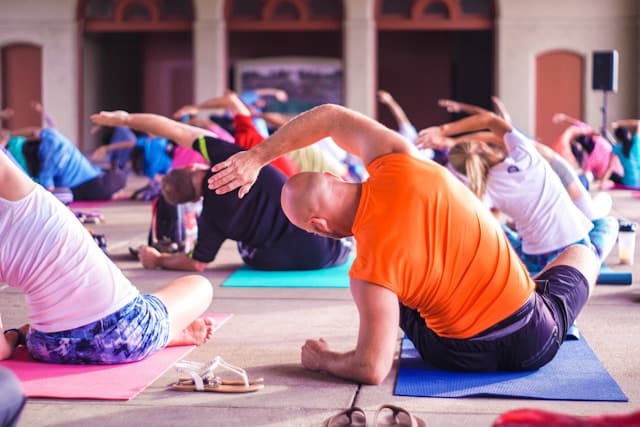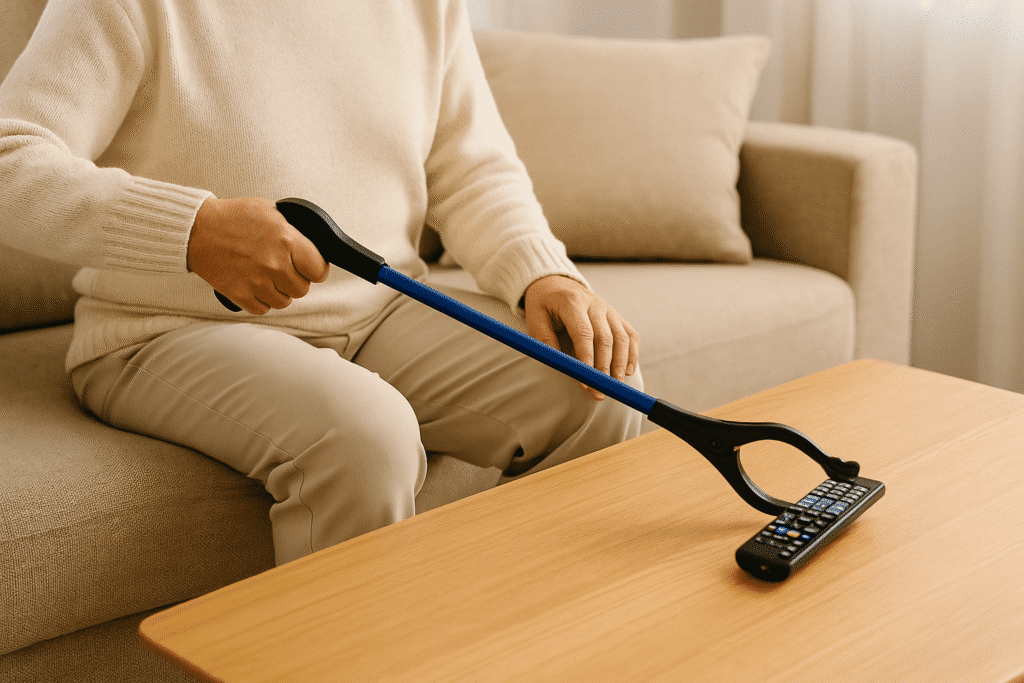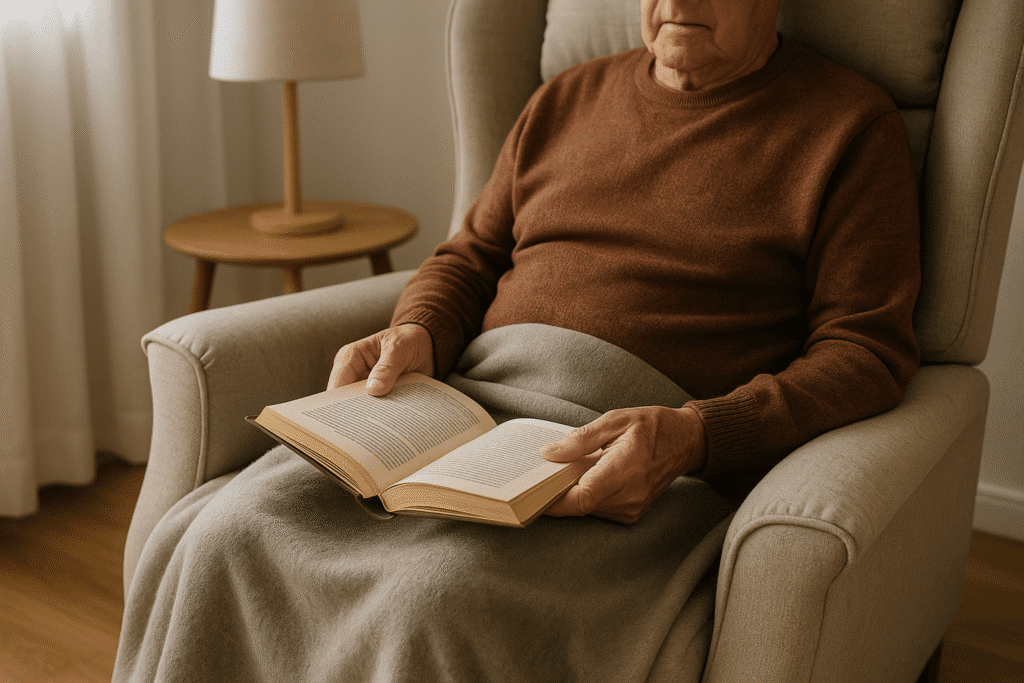Using a walking stick can make a big difference in how steady and confident you feel when moving around.
If you’re wondering how to use a walking stick for seniors safely and correctly, this simple guide will walk you through everything you need to know, from choosing the right stick to using it with proper balance and posture.
Key Summary:
To use a walking stick correctly, hold it on your stronger side and move it forward with your weaker leg. Keep your back straight, eyes ahead, and take small, steady steps. The stick should reach your wrist crease with a slight elbow bend to improve balance, reduce strain, and make walking safer and easier.
Why Walking Sticks Matter for Seniors
As we get older, it’s common to feel a bit less steady on our feet. In fact, studies show that nearly 40% of adults over 65 have some difficulty walking, and about 1 in 5 rely on a mobility aid like a cane or walking stick for daily activities.
A walking stick offers not just physical support, but also gives peace of mind and helps older adults stay active and independent longer.
Here’s why walking sticks are so helpful for seniors:
- Improve balance and stability during walking and standing.
- Reduce fall risk, especially on uneven or slippery surfaces.
- Ease pressure on joints, particularly for those with arthritis or hip and knee pain.
- Promote independence, making it easier to get around without needing constant help.
- Encourage better posture, helping you stay upright and confident.
A walking stick isn’t a sign of weakness; it’s a smart tool for safety and mobility. When used properly, it can help you walk farther, stand taller, and feel steadier every day.
Read more: How to make a home safe for the elderly
How to Use a Walking Stick for Seniors Properly
Knowing how to hold and move with your walking stick makes all the difference. The right technique can improve comfort, reduce strain, and make walking much safer.
1. Hold the Stick on Your Stronger Side
Always hold the walking stick in the hand opposite your weaker or injured leg. This might feel unusual at first, but it gives you better balance.
Example: If your right leg feels weak, hold the stick in your left hand. When you take a step with your weak leg, move the stick forward at the same time. The stick supports your weight as your weaker leg moves.
Why it matters:
- Keeps your weight evenly supported.
- Reduces stress on sore joints.
- Improves stability with every step.
2. Use the Correct Walking Rhythm
The basic rhythm is simple: Stick and weak leg forward together, then the strong leg follows.
Step-by-step:
- Move the stick and your weaker leg forward at the same time.
- Step forward with your stronger leg while placing your weight through the stick.
- Keep your eyes forward, not down, to maintain good posture.
This natural rhythm makes your walk smooth, safe, and less tiring.
3. Check the Height of Your Walking Stick
A walking stick that’s too short or too tall can cause shoulder, wrist, or back pain.
How to measure it:
- Stand up straight with your arms relaxed at your sides.
- The top of the stick should reach the crease of your wrist.
- Your elbow should bend slightly (about 15 degrees) when you hold the handle.
Tip: Adjustable walking sticks make it easy to fine-tune the height for perfect comfort.
4. Using the Stick on Stairs
Stairs can be tricky, but with the right technique, you can manage them safely.
When going up:
- Step up first with your stronger leg.
- Then move the stick and weaker leg up together.
When going down:
- Place the stick on the step below first.
- Move your weaker leg down next, then your stronger leg follows.
Remember: A simple way to remember is “up with the good, down with the bad.” Use handrails whenever possible for extra safety.
5. Sitting Down and Standing Up
When sitting, make sure your chair is stable and not too low.
To sit down:
- Back up until you feel the chair against your legs.
- Place the stick in your stronger hand.
- Use the other hand to grip the armrest or chair for support as you lower yourself slowly.
To stand up:
- Place the stick beside you, not in front.
- Push up using your stronger leg and hand.
- Once upright, grab the stick and steady yourself before walking.
Avoid using the walking stick alone to pull yourself up; it’s for balance, not lifting.
6. Maintain Good Posture
Try not to lean too much on your stick. Keep your shoulders relaxed and your back straight. This posture helps your balance and prevents strain.
Good habits:
- Look ahead, not at your feet.
- Keep steps small and steady.
- Take your time; confidence builds with practice.
Common Mistakes to Avoid When Using a Walking Stick
Even a small mistake in how you use a walking stick can affect your balance or cause discomfort. Here are some common errors seniors make and how to fix them:
- Holding the stick on the wrong side. Always use it on the side of your stronger leg to support your weaker one.
- Using the wrong height. A stick that’s too short can strain your back, while one that’s too tall can hurt your shoulder.
- Leaning too heavily on the stick. It’s for balance, not full body weight support.
- Using worn-out rubber tips. Replace tips as soon as they look smooth or cracked to prevent slipping.
- Looking down while walking. Keep your eyes ahead to stay steady and prevent dizziness.
- Walking too fast or unevenly. Take small, controlled steps at your own pace.
Read more: Daily living tips for older people
How to Choose the Right Walking Stick
Picking the right walking stick can make a big difference in how comfortable and secure you feel. The best stick fits your body, your environment, and your daily habits.
Choose the Right Type for Your Needs
There are several types of walking sticks designed for different situations.
- Standard walking sticks are ideal for light support indoors or short walks.
- Adjustable or folding sticks work well if you travel or want flexibility in height.
- Quad canes (with a four-point base) offer extra balance and are great for anyone recovering from surgery or balance issues.
- Hiking or trekking poles give strong outdoor stability and absorb shock on rough surfaces.
If you’re unsure, start with a standard or adjustable cane and talk to a therapist if you need more stability.
Pick a Comfortable Handle
The handle is what you’ll hold most of the time, so comfort matters.
- Ergonomic or offset handles reduce wrist strain.
- Derby and T-handles are easy to grip and work well for daily use.
- Foam or rubber grips help prevent slipping and reduce pressure on your hands.
Try holding a few different styles in person if possible. I often tell seniors I work with to choose one that feels “natural” in the hand; if it feels awkward, it probably is.
Get the Height Right
A walking stick that fits your height keeps your body aligned and reduces fatigue.
To measure:
- Stand upright with arms at your sides.
- The top of the stick should reach your wrist crease.
- Your elbow should bend slightly (about 15 degrees) when holding the handle.
Adjustable sticks make this process easy, and many come with height marks for guidance.
Check the Material and Weight
The material affects how light, durable, and stable your stick feels.
- Wooden sticks are sturdy and traditional but heavier.
- Aluminum sticks are lightweight and ideal for travel.
- Carbon fiber models offer top strength and comfort with minimal weight.
Also, make sure the rubber tip is high quality; it provides traction and absorbs impact when walking.
Look for Safety Features
Modern walking sticks often come with thoughtful safety additions.
- Non-slip rubber tips for better traction.
- Reflective strips for visibility at night.
- Wrist straps so you don’t drop the stick while moving.
Some even include built-in LED lights or folding mechanisms for convenience.
Final Words
Using a walking stick isn’t about limitation; it’s about freedom and safety.
The right stick, used correctly, can help you stay active, steady, and confident in your daily routine. Remember to choose a comfortable design, adjust it to your height, and replace worn parts as needed.
If you or someone you care for is unsure where to start, talk to a physical therapist or mobility specialist. A few small adjustments can make a world of difference in balance and peace of mind.
FAQs
How do I know if I need a walking stick?
If you feel unsteady while walking, rely on furniture for balance, or worry about falling, a walking stick may help. It provides extra support and can greatly improve your confidence and safety.
Should I use one stick or two?
Most people only need one walking stick. Two may be helpful for those with balance issues on both sides or for outdoor walking, similar to trekking poles.
What’s the difference between a cane and a walking stick?
A cane is typically designed for medical support and balance, while a walking stick is often used for light assistance or hiking. Many modern “canes” combine both functions.
How do I measure the correct height?
Stand straight with your arms relaxed. The top of the stick should reach your wrist crease, allowing your elbow to bend slightly (around 15 degrees).
Can I use a walking stick on stairs safely?
Yes, but follow the rule “up with the good, down with the bad.” Use your stronger leg first when going up, and your walking stick first when going down. Always use handrails if available.
When should I replace my walking stick?
Replace your stick if it becomes wobbly, the rubber tip is worn, or the handle feels loose. Regular maintenance keeps it safe and reliable for everyday use.
Mark has over 10 years of hands-on experience in senior care. He founded ElderSavvy to provide honest, easy-to-follow advice on tools that support comfort, safety, and independence. Mark oversees all content and product reviews, guided by insights from caregivers, health professionals, and real-life use.









